M
Leave a Legacy of Giving
You can support our mission of changing lives by saving sight in multiple ways!
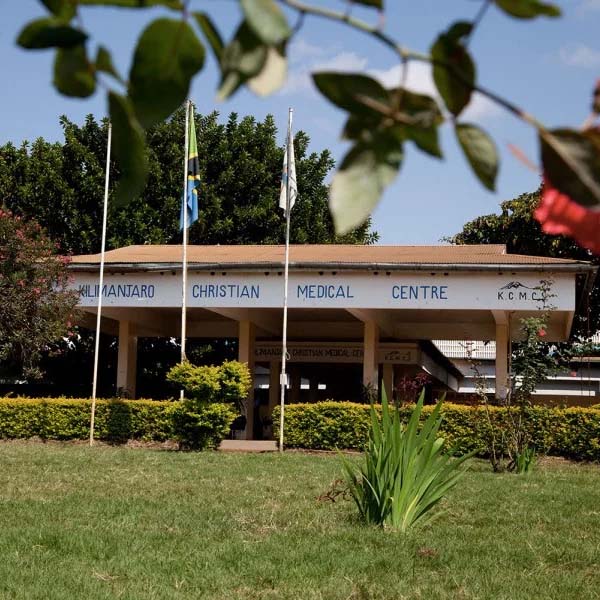
On July 2, 2021, Saving Sight distributed 6 corneal tissues to the Donor Network of Arizona to be used by one of their surgeons in Tanzania for a mission trip.
Dr. LeeSa Jackson joined Dr. Elisante Jackson Muna at the Kilimanjaro Christian Medical Center to perform a total of 17 gratis surgeries between the dates of July 5th-16th, to those in need.
This trip was not Dr. Jackson’s first to Tanzania. In 2018, Dr. Jackson traveled to Tanzania to perform 18 corneal transplants.
The medical team gathered stories from each recipient. Read the impact these sight-saving corneal transplants had for the corneal recipients below.

[Saving Sight recipients, Top L-R: Edson Mika, Bright Shipella, Meshack Nzowa; Bottom
L-R: Joshua Martin, Omary Hindu, Neema Mkwizu]
Edson Mika is a 31-year-old medical doctor who works as a general practitioner in the Dodoma region. The most challenging problem for Edson is his poor vision from keratoconus. Overtime, his keratoconus became worse and worse, and his poor vision became a major problem in his career. He could not see to take care of his patients or write in his patients’ charts. Edson tried a variety of medicines to aid his vision, but there was little benefit. Edson greatly appreciates the cornea donation because, as he notes, “we all have things to do in our lives, so it is important to have the donation.” More simply, Edson “thanks the donor very much.” As a general doctor who has experienced a cornea transplant, Edson believes organ transplantation is good because it allows people to continue on with their lives in the best way. He says that we should ask the question, “Does it help me now?” The advice Edson would give someone in his position is to take full advantage of the ability to see well again. He indicates that his poor vision before the cornea transplant was the only thing holding him back and now he hopes to “progress well” in his career as a doctor.
Bright Shipella is a 12-year-old boy from Dodoma, the capital of Tanzania. Bright lives with his two siblings and loves to play soccer. However, due to his poor vision from keratoconus, Bright couldn’t see the ball to play soccer anymore. Bright says he has fought through the inflammation of his eyes and poor vision. He wishes to improve his soccer skills, but only wants to compete recreationally or on the local level. As a prime career goal, Bright plans on becoming a doctor. Bright sends the following message to others who may be considering a cornea transplant. “I feel good. My eye vision is performing well. I can now see the blackboard.” (likely referencing the blackboard near the hospital bed.)
Meshak Nzowa is a 20-year-old young man from Tanzania who lives with his parents and younger brother. He previously tried traditional medicine, contact lenses, and glasses, which helped his cornea deformity, keratoconus, only temporarily or not at all. As a student, Meshak finds it extremely difficult to read a book. When he attends local basketball game, Meshak is unable to see the score. At night, he finds it challenging to walk because he cannot see his way. Because of these difficulties, Meshak would tell the donor that is truly made a difference and that it is without a doubt helpful. His advice to people in his position it to recognize the importance of the problem earlier on so they can make the most of their remaining life. Now that he has had his cornea transplant surgery, Meshak hopes to become ore involved in the local basketball leagues as a player, not just a fan. His short-term goals are to continue his education to be accepted into high school and then into a university. Meshak’s prime long-term goals is to become a doctor, specifically an ophthalmologist, in order to help patients, like himself who have keratoconus. Meshak is confident that he will be able to study much better now with his improved vision, so he sees these goals within his grasp.
Joshua Martin is a 19-year-old student who attends Karagwe University. He lives at the university in the Karagwe District of the Kagera Region. Joshua has many brothers and a younger sister who live with his parents at his family home. In Joshua’s free time, he loves to draw letters, various types of calligraphy, and portraits of people. Due to Joshua’s poor vision in his left eye from keratoconus, he had difficulty at school taking down information from the blackboard and reading books, even with the help of friends. The keratoconus eventually affected Joshua’s vision so severely in his left eye that he only used one eye, his right eye, to do school related tasks. At this point, he considered dropping out of the university because of his poor vision and “doing anything that would possibly fit my society.” To the person who donated the cornea, Joshua says, “I just give a good thanks to him or her whomever he or she is because they just changed my whole life.” Now that Joshua’s vision has improved after the cornea transplant in his left eye, he plans to continue his education at Karagwe University.
Omary Idd Hindu is a 25-year-old ticket salesman from Babati Mjini District in the Manyara Region. In his daily life, Omary reads over, cuts, and sells many train tickets with very small text. His poor vision has made his work as a train ticket salesman significantly more difficult, almost nearly impossible. Omary has corneal scarring due to hydrops associated with keratoconus. His poor vision began after he began scratching his eyes as a result of exposure to a strong perfume which irritated his eyes. In an effort to improve his vision, Omary tried multiple mediciations that, in the end, did not help. Omary has had to wait years for his cornea transplant surgery. To the person who donated the cornea, Omary says, “God bless them, and I am so thankful for that…And by the help of God and the doctors, I can be better now.”
Neema Omary Mkwizu is a 12-year-old girl from the Wilaya ya Arusha Mjini District in the Arusha Region. Neema is an only-child, which is rare in the Tanzanian culture. When Neema is not attending school, she loves to read and write about historical information. Neema’s case of keratoconus occurred idiopathically. She has no associated risk factors, or systemic or ocular conditions associated with her keratoconus. Her vision was not helped by other treatments, including spectacles. To the person who donated the cornea, Neema simply states, “thank you.” To others who may be in her position, she advises them to read books and, as a result, gain knowledge. Neema’s favorite historical location is the Amazon Rainforest, which she hopes to travel to and learn more about in her future. Neema plans to become a history teacher or an eye doctor, specifically a cornea specialist, so that she can treat others with her same problem.
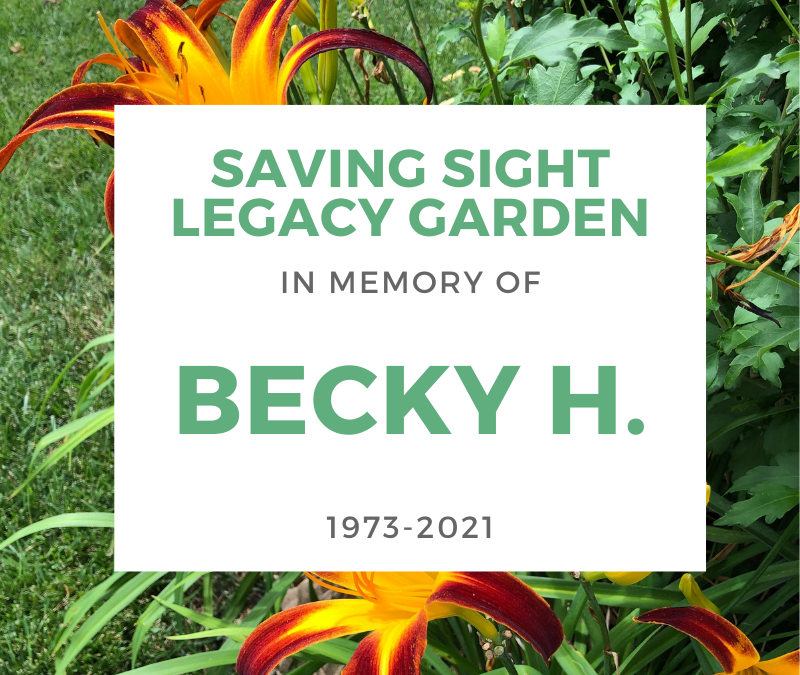

In Memory of Becky H., 1973-2021
“Becky was a strong advocate for those in need, especially children. She loved genealogy, German food, and her family and friends,” says Eric.
#LegacyGarden #DonorHero
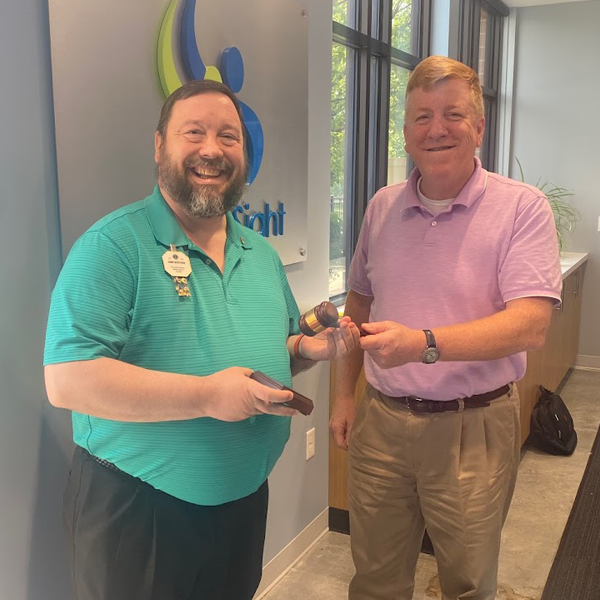

[pictured L-R: Pat Martchink passing the gavel to Larry Boettcher; Cassidy Obermark being honored for her board service; the board meeting at the Kansas City C office at the June meeting.]
Kansas City, Mo. (July 1, 2021) – Saving Sight is pleased to welcome four new people to its Board of Directors for the 2021-2022 fiscal year (July 1 – June 30). Welcome Council Chair Lion Bob Noellsch, Vice-Council Chair Lion Devin Struttmann, Lion Mike Sliger, and Wichita community board member Marc Vincent. PDG Lion Scott Sattler remains on the board and switched seats to represent Lions District M-1, Lion Larry Boettcher was re-elected to a second term, as well as community members Jeff Schaeperkoetter and Amy Leslie.
Board members are key to the organization’s success. They actively participate in long-range planning and monitor the organization’s financial health and overall performance. As highly visible members of their communities, the board members also enhance Saving Sight’s public standing by sharing the mission, accomplishments, and goals with Lions clubs, the general public, and other partner organizations. As Lion board members, these individuals also keep their districts informed about Saving Sight.
“We are able to change more lives by saving sight due to our board members engagement, leadership, support and oversight,” said Tony Bavuso, chief executive officer.
In addition to welcoming new members to the board, Saving Sight also expressed gratitude to three individuals who retired from the board of directors on June 1, 2021. We were honored to have PCC George Winkeler, Jr., PDG Roger Tiemann, and Lion Dr. Cassidy Obermark serve on our board and thank them for their valuable service.
At the June Board of Directors meeting, the board elected its 2021-2022 leadership team.
These board members were elected to leadership roles for the new fiscal year:
President: PCC Larry Boettcher, MD-26 M4
Vice President: Lion Pat Martchink, MD-26 M2
Treasurer: Lion Mike Oldelehr, MD-26 M7
Secretary: PDG Scott Sattler, MD-26 M1
At the June board meeting, past president Lion Pat Martchink ceremoniously passed the gavel to newly elected president PCC Larry Boettcher. Pat will serve as vice president for the 2021-2022 fiscal year to ensure a smooth leadership transition.
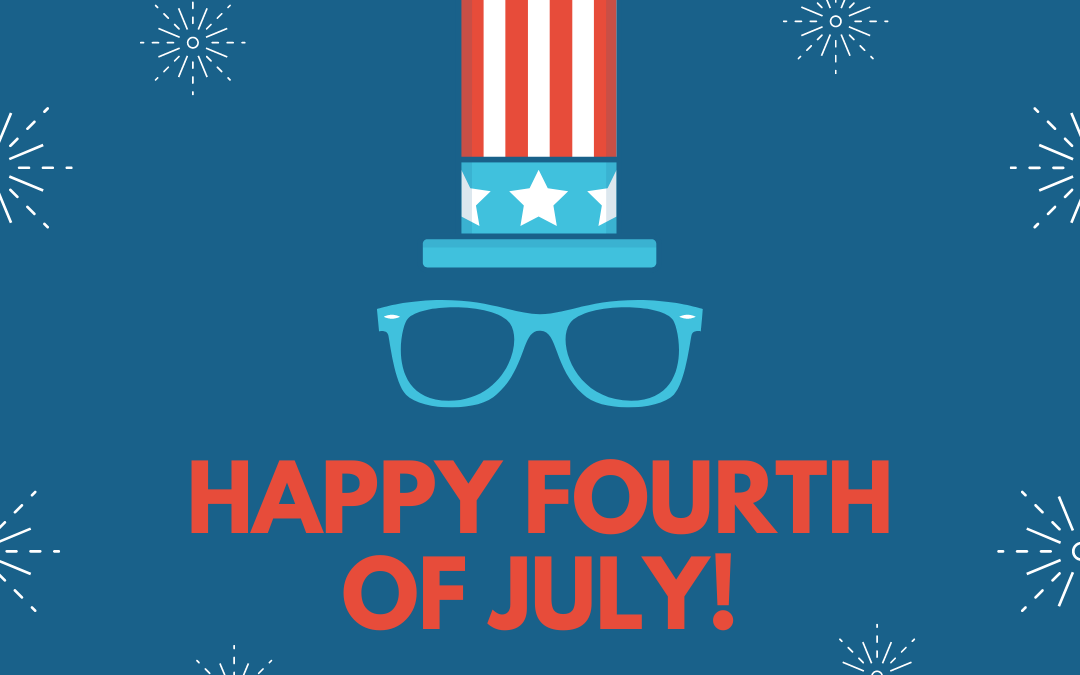

The U.S. Consumer Product Safety Commission reports that there are 9,000 fireworks-related injuries each year in the U.S. Thirty percent of those are eye injuries, and one-fourth of those eye injuries result in blindness. What’s more, children account for the majority of fireworks-injury victims, and for children under 5, sparklers — which burn at 2,000 degrees Fahrenheit and can cause third-degree burns — account for one-third of fireworks-related injuries.
For these reasons, the American Academy of Ophthalmology encourages you to follow these recommendations:
If you do decide to shoot off fireworks yourself, be sure to follow all safety precautions, protect your eyes, and keep children a safe distance away. The staff at Saving Sight wishes you a safe and fun-filled Independence Day weekend
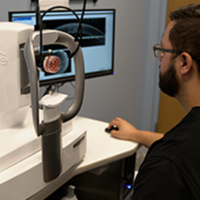

“The OCT is a big microscope that measures the thickness of the cornea, and we use it to measure our corneas before we start processing for our DSAEK or ALK processing. We also take images after processing so the surgeon can see what the processed tissue actually looks like. It gives us more insight on the quality of the tissue and if it will be suitable for the surgery type we are offering it for. We can be proactive in what we offer to the surgeons,” says Debora Van Klinken-Muntz, Lead Laboratory Technician.
“Using it as an eye bank saves us a lot of time. It also lets us be good stewards of the tissue we receive. I don’t know how we could do eye banking without an OCT machine.”